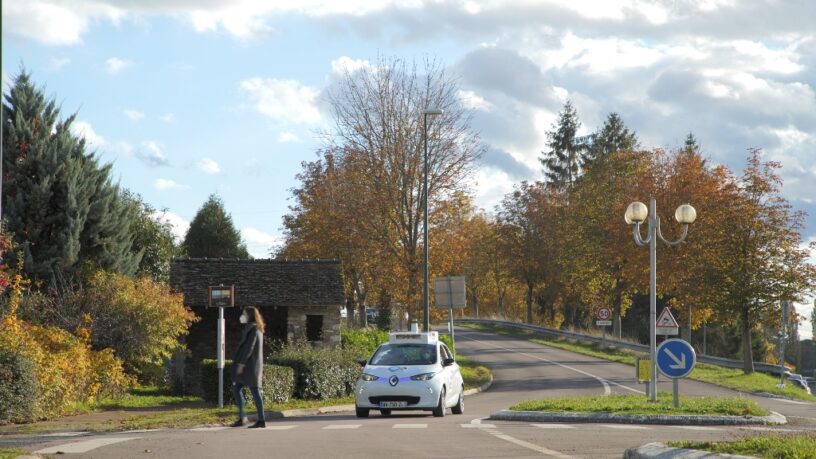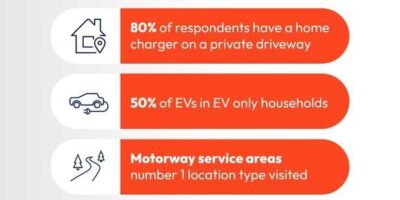Groupe Renault has completed a ground-breaking three-year research project in France exploring and understanding the technology required and conditions needed for autonomous vehicles to work away from built-up urban areas. The trial was made up of two key experiments, including one completed using a specially developed autonomous Renault ZOE.
Starting in September 2017 in a region to the southwest of Paris, the Tornado project, led by Groupe Renault and Rambouillet Territoires, collaborated with 10 industrial and academic partners to test the requirements for autonomous mobility services to work in less populated and less dense suburban and rural areas.
With large portions of the UK and Europe made up of suburban and rural areas, the findings from this advanced project could be used to help inform how autonomous mobility might work beyond bustling cities in these types of areas that present unique challenges to autonomous vehicles.
Groupe Renault has extensive experience in trialling innovative projects in busier, urban areas to understand the complexities in the adoption of autonomous vehicles. In 2019, a panel of around 100 people took part in the Paris-Saclay autonomous lab – a trial of an on-demand car service using two autonomous Renault ZOE Cab prototypes in an initiative of five partners. The trial set out to test the technical aspects of an on-demand car sharing service and understand how it can be adopted and utilised by end users.
With the Tornado project, Groupe Renault set out to investigate the needs for autonomous mobility solutions to work in more rural and suburban areas, complementing its ongoing involvement in urban autonomous trials. The demands of mobility infrastructure are just as important in these areas where there is a strong reliance on public transport for residents and workers.
The research project consisted of two key trials. The first was an on-demand and shared car service using an autonomous Renault ZOE to provide a direct link between Gazeran train station and Bel Air – La Foret business park in Rambouillet (southwest of Paris). The second was a separate shuttle service calling at predefined stops within the Bel Air business park itself. Both experiments aimed to deliver a reliable, connected autonomous mobility service.
Taking autonomous technologies beyond the city
Driving in suburban and rural areas differs dramatically to urban areas. The Tornado project’s technical focus was to define and develop autonomous driving solutions, and communication technologies and infrastructures, that maximise safety and address the specific requirements for suburban and rural areas.
From a safety aspect, everything from hardware and advanced software to embedded and remote solutions were taken into consideration, as well as vehicle-to-infrastructure communications.
The specific and complex characteristics of quieter, more sparsely populated areas were fully analysed as part of the project, including narrow streets, roundabouts and tunnels, obstacles which reduce visibility, lack of road markings, plus changes in roadside configurations and boundaries – issues that aren’t always as consistent as they are in urban areas.
The goal for Groupe Renault was to have an all-electric Renault ZOE drive autonomously over an eight-mile (13km) journey encompassing all of these varying features and challenges. This journey was a route that would be a direct feeder service between Gazeran train station and Bel Air business park.
The outcomes of this included the following:
Enhancing the autonomous vehicle’s perception capabilities, enabling it to sense the surroundings within a 360-degree field, including type of object, size and distance from the vehicle, in real time
Being able to locate and control the autonomous vehicle with 200mm accuracy to ensure it stays on its path, on very narrow roads, regardless of the roadside conditions – for example with or without painted lines or just a verge
Dealing with temporary loss of GPS signal or operating with zero visibility, for example when driving through one-lane tunnels where priority is given to one side or the other
Reaching speeds that are deemed acceptable by everyday drivers and passengers and that match regular traffic speeds
Over the eight-mile (13km) stretch, tests were conducted on connected infrastructure components such as connected traffic lights and fixed cameras that enable vehicles to see objects beyond their field of perception.
For the autonomous shuttle within the business park itself, users called on the service via the same mobile app as the autonomous Renault ZOE, synced together to provide a continuous, seamless service between the vehicles. Key areas this focused on were advanced perception capabilities, using the connected infrastructure’s capabilities to broaden perception, and ensure the vehicle stayed within its safety perimeters.
Community involvement and requirements
For the Tornado project to work, people’s mobility habits in the area – and their views of autonomous vehicles – needed to be understood. Their level of interest in the possibility of future autonomous transport services was also key, and how targeted, safe, shared and environmentally friendly mobility could complement existing setups in areas like Rambouillet.
Connected infrastructure is key in keeping people moving in rural and suburban areas, and it’s something that’s expected to be convenient and appealing by those using it, which is why it was important to involve local authorities. The community – consisting of around 100 people from the area’s MobiLab – were active in various stages of the project.
Numerous sessions of autonomous Renault ZOE trials, and associated workshops, were aimed at studying how autonomous vehicles can be adopted, as well as monitoring the human factors regarding peoples’ feelings towards these ground-breaking new technologies. From these shared experiences and real-life responses, the technical components could be upgraded or adapted as necessary to suit the expectations of the user community.
One of these changes, based on the feedback, was the operating speed of the autonomous ZOEs that were in use. In 2019 it could drive itself up to speeds of 31mph (50km/h), however because users expected the service to more closely match real-life driving and real-life speed limits, they can now drive up to 43mph (70km/h) along certain parts of the route.
Public-private teamwork
The Tornado project was led by the Fonds Unique Interministeriel (FUI) for Regions, financed by Bpifrance and Ile-de-France, Auvergne-Rhone-Alpes and Occitanie regional authorities. The variety of partners brought in experts pooling their knowledge, skills and innovative capacity to serve the area, led by Groupe Renault and Rambouillet Territoires.
Renault at the forefront of autonomous innovation
The Tornado project is just one of several projects Renault has worked on to understand the complexities in the adoption of autonomous vehicles. In 2019, a panel of around 100 people took part in the Paris-Saclay Autonomous Lab – a public trial of an on-demand car service using two autonomous Renault ZOE Cab prototypes.
The trial set out to understand how autonomous mobility services could be adopted by end users, and to test the technical aspects an on-demand mobility service would require.
Like the Tornado project, user feedback was key in understanding how autonomous mobility services would work in real life, with testimonials and data from the panel informing how the service can be adapted to better suit the needs of the people using it, and offer the best autonomous and shared mobility service in the future.
The vehicles used were autonomous Renault ZOE Cab prototypes, used during the daytime to move around the Paris-Saclay urban campus and for everyday mobility – going to one of the schools or laboratories on campus, head to lunch or play sports.
One of the vehicles was equipped with an innovative large door on one side of the vehicle spanning the length of the interior, allowing easy access to the whole cabin. On the other prototype, a large rear door on the passenger side allows access to rear seats and the rear-facing front passenger seat. This version provided the kind of environment users expect from a car sharing service.
Both versions feature screens inside so passengers can view their trip, as well as a mobile app to hail the ZOEs and a range of advanced features to keep passengers comfortable and entertained.
*Article Source http://www.press.renault.co.uk








